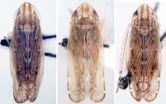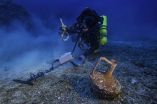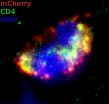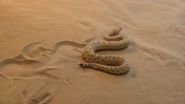(Press-News.org) MADISON, Wis. – In Wisconsin, bioenergy is for the birds. Really.
In a study published today in the journal PLOS ONE, University of Wisconsin-Madison and Wisconsin Department of Natural Resources (DNR) scientists examined whether corn and perennial grassland fields in southern Wisconsin could provide both biomass for bioenergy production and bountiful bird habitat.
The research team found that where there are grasslands, there are birds. Grass-and-wildflower-dominated fields supported more than three times as many bird species as cornfields, including 10 imperiled species found only in the grasslands. These grassland fields can also produce ample biomass for renewable fuels.
Monica Turner, UW-Madison professor of zoology, and study lead author Peter Blank, a postdoctoral researcher in her lab, hope the findings help drive decisions that benefit both birds and biofuels, too, by providing information for land managers, farmers, conservationists and policy makers as the bioenergy industry ramps up, particularly in Wisconsin and the central U.S.
"As bioenergy production demand increases, we should pay attention to the ecological consequences," says Turner.
This is especially true for grassland birds, as populations of species like the eastern meadowlark, dickcissel and the bobolink have declined in recent decades.
The study began when UW-Madison's Carol Williams, coordinator of the Wisconsin Grasslands Bioenergy Network, and the DNR's David Sample approached Turner and asked for her help. They wanted to know: "What are the implications of the decisions we make about how we use our lands?" says Turner.
The research team carefully selected 30 different grassland sites — three of which are already used for small-scale bioenergy production — and 11 cornfields in southern Wisconsin. Over the course of two years, the researchers characterized the vegetation growing in each field, calculated and estimated the biomass yields possible, and counted the total numbers of birds and bird species observed in them.
According to Blank and Turner, the study is one of the first to examine grassland fields already producing biomass for biofuels and is one of only a few analyses to examine the impact of bioenergy production on birds.
While previous studies suggest corn is a more profitable biofuel crop than grasses and other types of vegetation, the new findings indicate grassland fields may represent an acceptable tradeoff between creating biomass for bioenergy and providing habitat for grassland birds. The landscape could benefit other species, too.
Because they are perennial, the grassland fields can also be used year after year, following best management practices that preserve the health of the soil and provide reliable habitat for migratory birds.
"Plant diversity is good for wildlife diversity," says Blank. "Our study suggests diverse bioenergy crop fields could benefit birds more so than less diverse fields."
Among the grasslands studied, the team found monoculture grasses supported fewer birds and fewer bird species than grasslands with a mix of grass types and other kinds of vegetation, like wildflowers.
The team found that the presence of grasslands within one kilometer of the study sites also helped boost bird species diversity and bird density in the area.
This is an opportunity, Turner says, to inform large-scale land use planning. By locating biomass-producing fields near existing grasslands, both birds and the biofuels industry can win.
Incentives for a conservation-minded approach could be used to help offset potential differences in profit, the researchers suggest. They also add that the biomass yields calculated in the study may represent the low end of what is possible, given that one of the two study years, 2012, occurred during a significant drought period in the state.
"The study shows species generally really benefit from the practice," says Blank. "We really can produce bioenergy and provide habitat for rare birds in the state."
INFORMATION:
The study was supported by the Wisconsin Department of Natural Resources.
—Kelly April Tyrrell, ktyrrell2@wisc.edu, 608-262-9772
CONTACT: Peter Blank, 608-265-8001, pblank@wisc.edu (cell phone available upon request); Monica Turner, 608-262-2592 (beginning 10/10/14), turnermg@wisc.edu
Three new species of leafhoppers from China in the genus Futasujinus were recently identified during a review of leafhoppers in museum collections in China, the UK, and Illinois. One of them, Futasujinus dietrichi, was "named after Dr. Chris Dietrich, University of Illinois, USA, in recognition of his good work on leafhoppers." The new species are described in an article in Annals of the Entomological Society of America.
The other two species are Futasujinus truncatus and Futasujinus hastatus. Both species epithets allude to processes on their aedeagal shafts.
All three ...
Tempe, Ariz. (Oct. 9, 2014) - New Ebola research demonstrates that quick and forceful implementation of control interventions are necessary to control outbreaks and avoid far worse scenarios.
Researchers analyzed up-to-date epidemiological data of Ebola cases in Nigeria as of Oct. 1, 2014, in order to estimate the case fatality rate, proportion of health care workers infected, transmission progression and impact of control interventions on the size of the epidemic.
"Rapid and forceful control measures are necessary as is demonstrated by the Nigerian success story. This ...
A Greek and international team of divers and archaeologists has retrieved stunning new finds from an ancient Greek ship that sank more than 2,000 years ago off the remote island of Antikythera. The rescued antiquities include tableware, ship components, and a giant bronze spear that would have belonged to a life-sized warrior statue.
The Antikythera wreck was first discovered in 1900 by sponge divers who were blown off course by a storm. They subsequently recovered a spectacular haul of ancient treasure including bronze and marble statues, jewellery, furniture, luxury ...
WEST LAFAYETTE, Ind. – A new technique makes it possible to quickly detect the presence of drugs or to monitor certain medical conditions using only a single drop of blood or urine, representing a potential tool for clinicians and law enforcement.
The technique works by extracting minute quantities of target molecules contained in specimens of blood, urine or other biological fluids, and then testing the sample with a mass spectrometer.
Testing carried out with the technology takes minutes, whereas conventional laboratory methods take hours or days to yield results ...
SAN FRANCISCO -- The information that interprets the genetic code in a new embryo differs depending on whether it comes from the father or mother, researchers at San Francisco State University have found.
The research, detailed in an article published today in the journal PLOS Genetics, sheds light on the multilayered process of how a sperm and egg pass along information needed for successful reproduction. Though one layer is the DNA code that is transferred, the new study identifies information not encoded by DNA, a so-called "epigenetic" layer of information that helps ...
Most women are infected with HIV through vaginal intercourse, and without effective vaccines or microbicides, women who cannot negotiate condom use by their partners remain vulnerable. How exactly the virus establishes infection in the female reproductive tract (FRT) remains poorly understood. A study published on October 9th in PLOS Pathogens reports surprising results from a study of HIV transmission in the FRT of rhesus macaques.
Most studies of HIV transmission after vaginal exposure to date have been done in rhesus macaques and focused on the cervix, the lower part ...
VIDEO:
This video explains research done to understand the motion used by sidewinder snakes to climb sandy slopes and to apply that motion to a snake-like robot. Researchers from Georgia Tech,...
Click here for more information.
The amazing ability of sidewinder snakes to quickly climb sandy slopes was once something biologists only vaguely understood and roboticists only dreamed of replicating. By studying the snakes in a unique bed of inclined sand and using a snake-like robot ...
CANCER RESEARCH UK scientists have discovered that lung cancers can lie dormant for over 20 years before suddenly turning into an aggressive form of the disease, according to a study published in Science* today (Thursday).
The team studied lung cancers from seven patients – including smokers, ex-smokers and never smokers. They found that after the first genetic mistakes that cause the cancer, it can exist undetected for many years until new, additional, faults trigger rapid growth of the disease.
During this expansion there is a surge of different genetic faults ...
When young mice with the rodent equivalent of a rare autism spectrum disorder (ASD), called Rett syndrome, were fed a diet supplemented with the synthetic oil triheptanoin, they lived longer than mice on regular diets. Importantly, their physical and behavioral symptoms were also less severe after being on the diet, according to results of new research from The Johns Hopkins University.
Researchers involved in the study think that triheptanoin improved the functioning of mitochondria, energy factories common to all cells. Since mitochondrial defects are seen in other ...
During their approximately 100-day lifespan in the bloodstream, red blood cells lose membrane surface area, volume, and hemoglobin content. A study publishing this week in PLOS Computational Biology finds that of these three changes, only the observed surface-area loss can be explained by RBCs shedding small hemoglobin-containing vesicles budding off their cells' membrane.
Red blood cell concentration, mean volume, and hemoglobin content are routinely measured in the complete blood count, a fundamental clinical test essential to the screening, diagnosis, and management ...




